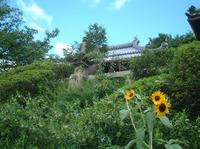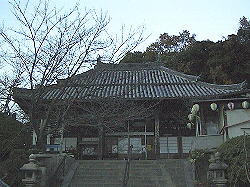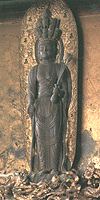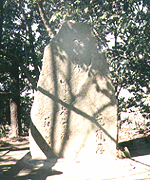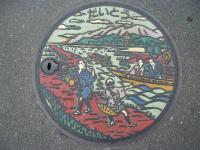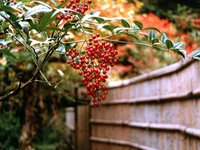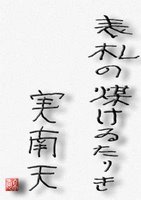[ . BACK to TOP . ]
:::::::::::::::::::::::::::::::::::::::::::::::::::::::::::::::::::::::::::::::::::::::::::::::::::::
Nightingale, bush warbler (uguisu)
***** Location: Japan
***** Season: Various, see below
***** Category: Animal
*****************************
Explanation
The latin name
Cettia diphone refers to the bush warbler.
The latin name
Luscinia megarhynchos refers to the nightingale of Japanese poetry.

Its sound is heared as
hooo hokekyoo .
Hokekyo is the name of the famous Lotus Sutra ホケキョウ(法華経).
. Sutras お経 o-kyoo .
:::::::::::::::::::::::::::::::::::::::::::::::::::::::::::::::::::::::::::::::::::::::::::::::::::::
quote
If not for the call
of the bush warbler coming
out of the valley,
who then would be aware of
the arrival of springtime?
Original by Ôe no Chisato, nephew of Ariwara no Narihira and another poet who flourished from the 890s to around 920 but whose birth and death dates are unknown. He has 10 poems in the Kokinshu.
鴬(うぐいす)の谷より出づる声なくは
春来ることを誰か知らまし
uguisu no tani yori izuru koe naku wa
haru kuru koto o tare ka shiramashi
The Kokin Wakashū (古今和歌集), literally meaning
"Collected Japanese Poems of Ancient and Modern Times",
and commonly abbreviated as Kokinshū (古今集), is an early anthology of the waka form of Japanese poetry.
... it was the first anthology to divide itself into seasonal and love poems. The primacy of poems about the seasons pioneered by the Kokinshū continues even today in the haiku tradition.
Kokin Wakashu
© More in the WIKIPEDIA !
:::::::::::::::::::::::::::::::::::::::::::::::::::::::::::::::::::::::::::::::::::::::::::::::::::::
kigo for spring
nightingale, ugusiu うぐいす、鶯
first nightingale, hatsu uguisu 初鶯
first call of the nightingale, uguisu no hatsune 鶯の初音
"nightingale flute", uguisu bue 鴬笛(うぐいすぶえ)
..... todome dori 禁鳥(とどめどり)
fragrant bird, nioidori 匂鳥
nightingales crossing the valley, uguisu no tani watari
鶯の谷渡り(うぐいすのたにわたり)
"telling us of spring", haru tsugedori 春告鳥
nightingale in a cage, kai ugusiu 飼鶯
"bird that sings at the flower-viewing season", hahami dori "花見鳥"
"bird that recites the sutras", kyooyomi dori 経読鳥
the sound reminds the Japanese of the name of the sutra "Hokkekyo".
"bird that recites poetry", utayomi dori
歌詠鳥(うたよみどり)
"Yellow powder bird", kinako dori 黄粉鳥(きなこどり)
kinako is the yellow powder of soybeans, eaten as a delicacy.
"yellow bird", kichoo 黄鳥(きちょう)
nest of the nightingale, uguisu no su
鶯の巣(うぐいすのす)
.................................................. ceremony in spring
Ritual nightingale singing competition,
uguisu awase 鶯合 (うぐいすあわせ)
"singing contest", naki awase 鳴合(なきあわせ),啼合(なきあわせ)
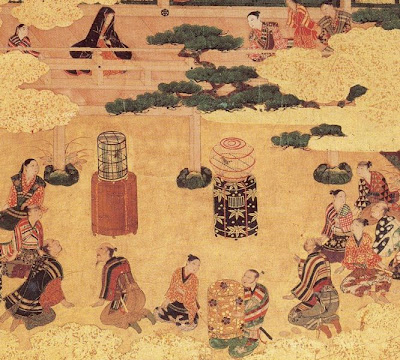 © PHOTO : commons.wikimedia.org
© PHOTO : commons.wikimedia.org
:::::::::::::::::::::::::::::::::::::::::::::::::::::::::::::::::::::::::::::::::::::::::::::::::::::
kigo for summer
summer bush warbler, natsu uguisu 夏鶯
late nightingale, zanoo 残鶯
..... ranoo 乱鶯
"old nightingale", old bush warbler, oi uguisu 老鶯
..... roo oo 老鶯
the nightingale cries of old age,
..... uguisu oi o naku 鶯老を鳴
:::::::::::::::::::::::::::::::::::::::::::::::::::::::::::::::::::::::::::::::::::::::::::::::::::::
kigo for winter
nightingale in winter, fuyu no uguisu
冬の鶯 (ふゆのうぐいす)
fuyu uguisu 冬鶯(ふゆうぐいす)
nightingale in the cold, kan ou 寒鶯(かんおう)
nightingale in the underbrush, yabu uguisu 藪鶯(やぶうぐいす)
sasanaki 笹鳴 (ささなき)
konaki 小鳴(こなき)
笹鳴も手持ぶさたの垣根哉
sasa naki mo temochi-busata no kakine kana
birdsong in bamboo grass--
too shy
for the fence
Kobayashi Issa 小林一茶
Kaki can be translated as "fence" or "hedge." The bird is young, hiding in the bamboo grass of winter, not at all ready for its spring solo on the fence/hedge. Shinji Ogawa notes that sasa naki ("birdsong in bamboo grass") has a special meaning in Japanese:
"In winter, the birdsong, especially that of a warbler, is not fully developed due to the low sex-drive. The fragmented birdsong in winter is called sasa-naki and has nothing to do with bamboo grass. Knowing this, Issa plays with the literal meaning of the word, sasa-naki, to juxtapose it to singing on the fence."
Tr. and Comment : David Lanoue
.............................................................................
sasanaki mo temochi-busata no kakine kana
by this hedge
young bush warblers, too
unsure and awkward
Tr. and Comment : Chris Drake
This hokku is part of a haibun travelog Issa wrote when he made a trip to Sawara in what is now called Chiba Prefecture, just northeast of Edo in the 10th month of 1810. He made the trip to pray at the grave of the haikai poet
Kassai (葛斎, Imaizumi Tsunemaru) who had recently died, and after praying at the grave he visited Kassai's house with one of Kassai's followers, Enao. It was in early lunar winter (the middle of November), and the leaves on the trees planted by Kassai were brightly colored. The trees in the hedge are implied to have been planted by Kassai and to represent him now that he himself is gone. Kassai's widow, also a haijin, had tears in her eyes -- surely because of her husband's death, though she elegantly explained to Issa that it was because birds greatly loved by the Buddha had visited their house again this year.
[The widow is obviously referring to the bush warblers and probably to the fact that one of the main calls of bush warblers sounds in Japanese like "Lo-, Lotus Sutra! Lo-, Lotus Sutra!" At the same time, she is also saying that her husband, now a dead soul or a "Buddha," loved bush warblers and is the cause of her tears.]
The birds near the hedge were still young bush warblers (uguisu no ko) who were flying around here and there, making only small cheeping sounds. To Issa the young bush warblers, who still haven't developed strong voices or wings, seem awkward and unsure of themselves as they fly around and around, looking for food. By adding "too" (mo), Issa indicates to the widow that he has understood her allegory about her grief and her husband's love of warblers, that is, his wife. In response Issa extends her image by suggesting that there is truly someone (to whom he's now talking) near the hedge (planted by Kassai) who is also bit lost and doesn't know what to do. This is surely Issa's way of expressing his respect and sympathy for Kassai's wife and her tears. At the same time, Issa seems to thank the widow for knowing very well how to share her feelings with him. The indirectness of the dialog deepens its feeling.
Issa's haibun also gives the hokku made by the widow, Motojo (もと女), in reply to Issa's hokku:
shigururu ya aruji ga itara hatsu-shigure
cold rain --
if he were with us
the first winter showers
The abstract reference to her husband by Motojo shows love and respect in Japanese and is not simply an abstract euphemism, as it appears to be when translated literally. (She is the "female owner" and her husband was the "male owner.") Motojo seems to be suggesting that if her husband were still there with them the cold showers that have been coming and going on this day would be much more than mere physical rain -- a simple statement that says a lot.
Later Issa and four other haijin friends and followers of Kassai composed a 36-verse kasen sequence for Kassai's soul. In this kasen, a hokku by Kassai (referred to as a "Buddha") was used as the hokku, and Issa began with the second verse, or wakiku.
:::::::::::::::::::::::::::::::::::::::::::::::::::::::::::::::::::::::::::::::::::::::::::::::::::::
Flower Trump Hanafuda
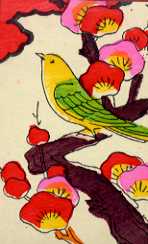 http://members.at.infoseek.co.jp/stone2/hanafuda12-1.html
http://members.at.infoseek.co.jp/stone2/hanafuda12-1.html
Plum and Nightingale, Ume ni Uguisu 梅に鶯
Read my details here !
:::::::::::::::::::::::::::::::::::::::::::::::::::::::::::::::::::::::::::::::::::::::::::::::::::::
Here is the famous story to shed light on the temperament of the three most famous warlords in Japanese history:
When confronted with a nightingale in a cage, which would not sing, each had his own approach to this situation.
Nobunaga
If the bird does not sing, kill it!
Hideyoshi
If the bird does not sing, I will make it sing!
Ieyasu
If the bird does not sing, I will wait until it sings!
Read my details here !
The BIRD, by the way, often translated as "Nightingale", was in fact
..... hototogisu, the little cuckoo ... .
*****************************
Worldwide use
Nachtigall
*****************************
Things found on the way
"Nightingale Flooring"
A special way to place wooden planks for a veranda or around the room of an important person during the Edo period, to avoid the penetrance of murderers or thieves into a room. The floor planks would squeak (sing) when a person stepped on it. The most famous example is in the Nijo Castle in Kyoto.
The sound when walking on it is different from that heard in normal houses, because the floor was laid out in a different way. It was suspended with iron clamps above a frame, so it could move up and down over the fixing nails when somebody walked upon it. This caused the nails to rub against the wooden planks and create a sound similar to the chirping of the nightingale.
nightingale flooring, uguisubari (鴬張り)
:::::::::::::::::::::::::::::::::::::::::::::::::::::::::::::::::::::::::::::::::::::::::::::::::::::
 uguisu no fun 鶯の糞 uguisu poo
Uguisu no Fun : Nightingale Droppings
uguisu no fun 鶯の糞 uguisu poo
Uguisu no Fun : Nightingale Droppings
Traditional Japanese Beauty Secrets
by Naomi Graham (Diaz)
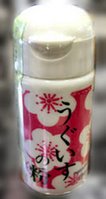
Now, during the course of my researching of geiko and maiko – I’ve come across numerous mentions of Uguisu no Fun, or, for those who really wish to be in the know, Nightingale Droppings (Uguisu no Fun sounds better, right?). I’ve always (secretly) wondered whether it worked or not.
Uguisu no Fun even has a special mention in one of my books
“The Japanese Way of Beauty” by Michelle Dominique Leigh, which contains the recipe and full instructions for use, along with a very special note at the end of the recipe mentioning it had been included in the book as it is one of the most respected traditional Japanese recipes. I’d be lying if I said I didn’t find the tradition intriguing.
I very carefully read the directions for use, as I certainly didn’t intend on any accidents due to misuse and according to the instructions, you are mix ½ teaspoon of the dried Uguisu no Fun with a few drops of warm water in the palm of your hand to form a paste. You then massage the paste into your skin using small circular motions – keeping well clear away from your eyes. So, I did just that - I put ½ teaspoon of the powder in my palm, mixed it with water, took a deep breath, and to the sounds of the “eeeeeeeeeeeewwwwwwwwww!” coming from the direction of my partner, I started massaging Uguisu no Fun into my face in small circular motions with a hint of a small, nervous smile of disbelief that I was even doing this in the first place.
Once the water is added to Uguisu no Fun – the musky smell became much stronger and I realized the instructions should have mentioned staying as far away from the nostrils as well as the eye area just to be on the safe side. “In the name of research” I chanted silently to myself as I massaged. Once I was done, I stared at myself in the mirror. Wow. There I was staring back with a very organic mask on my face. All of a sudden, I felt terribly empowered and the childish, playground taunts from my partner faded into the background when the realization of how brave I was hit me.
- - - - - Read the full story here :
immortalgeisha.com © 2001-2006 by Naomi Graham (Diaz)
. Recycling and Reuse in Edo - リサイクル と 再生 / 再使用 .
tori no fun kai 鳥の糞買い buying "bird droppings"
to make Uguisu no Fun.
*****************************
HAIKU
uguisu haiku by
. Matsuo Basho 松尾芭蕉 - Archives of the WKD .
鶯や餅に糞する縁の先
uguisu ya mochi ni fun suru en no saki
this damned warbler !
it left his droppings on the ricecakes
on the veranda
More translations and
Read my details here ! Tr. Gabi Greve
 鶯や 柳のうしろ 薮の前
鶯や 柳のうしろ 薮の前
uguisu ya yanagi no ushiro yabu no mae
this bush warbler !
behind the willows
in front of the thicket
 source : kikyou0123
. Haiku Sweets (haika 俳菓) .
source : kikyou0123
. Haiku Sweets (haika 俳菓) .
:::::::::::::::::::::::::::::::::::::::::::::::::::::::::::::::::::::::::::::::::::::::::::::::::::::
Issa has written quite a lot of haiku about this bird !
鶯も上鶯の垣根かな
uguisu mo jô uguisu no kakine kana
even among nightingales
royalty
on the fence
鶯のはねかへさるるつるべ哉
uguisu no hanekaesaruru tsurube kana
the nightingale
is bouncing about...
well bucket
鶯もとしのよらぬや山の酒
uguisu mo toshi no yoranu ya yama no sake
the nightingale, too
isn't growing old!
mountain sake
Tr. David Lanoue, read more haiku here !
:::::::::::::::::::::::::::::::::::::::::::::::::::::::::::::::::::::::::::::::::::::::::::::::::::::::::::::::::
老鶯の 手引かまほし ホトトギス
guide the old bushwarbler
with your hands, please,
young cuckoos
- Shared by Naotaka Uematsu -
Haiku Culture Magazine, 2013
*****************************
Related words
*****
Flower viewing season, hanami
*****
Saijiki of Japanese Ceremonies and Festivals
. THE BIRD SAIJIKI
:::::::::::::::::::::::::::::::::::::::::::::::::::::::::::::::::::::::::::::::::::::::::::::::::::::::::::::::::::::::::::
[ . BACK to DARUMA MUSEUM TOP . ]
[ . BACK to WORLDKIGO . TOP . ]
:::::::::::::::::::::::::::::::::::::::::::::::::::::::::::::::::::::::::::::::::::::::::::::::::::::::::::::::::::::::::::
